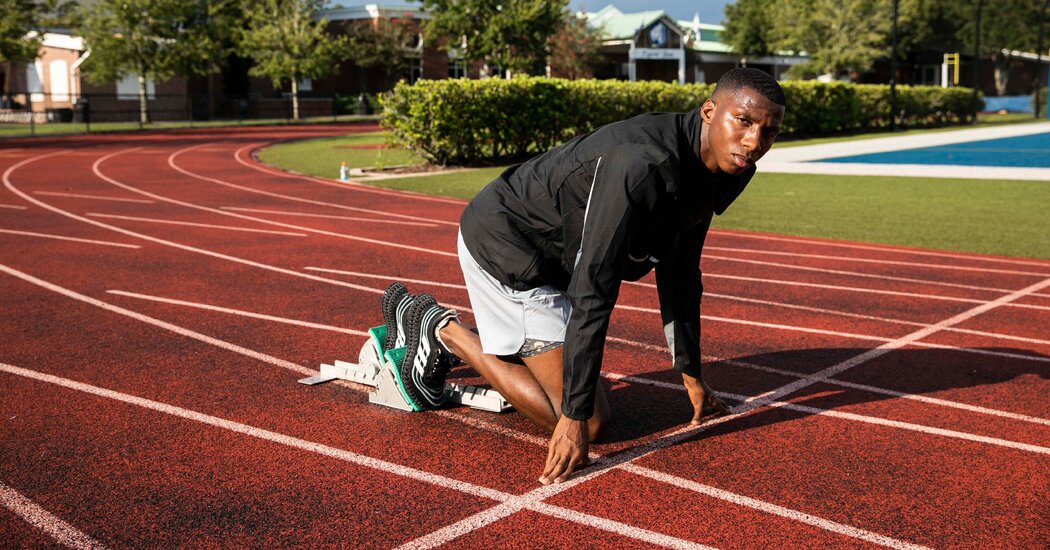
TAMPA, Fla. — When Erriyon Knighton, a few months past his 18th birthday, became the fourth-fastest 200-meter runner in history on April 30, his fellow sprinter Michael Cherry tweeted in amazement, “That boy got algebra on Monday.”
Knighton was still weeks away from graduating high school when he ran half a lap around the track in 19.49 seconds, lowering his own world junior record once held by Usain Bolt, at the L.S.U. Invitational in Baton Rouge, La.
Knighton had turned professional in January 2021, days before his 17th birthday. Months later, he finished fourth in the 200 at the Tokyo Olympics, so his victory at this low-key meet was not unexpected. It was how fast Knighton crossed the finish line at such a young age that was startling.
He enters this weekend’s United States track and field championships in Eugene, Ore., as a favorite, and is expected to qualify for the world championships to be held there in July, when he believes he can win.
Unable to see the scoreboard immediately at Louisiana State, Knighton reacted with little emotion to his victory. He knew he had run fast, but he did not yet know that his result was surpassed only by three of the greatest sprinters of all time — Bolt of Jamaica, the three-time Olympic champion at 200 meters who holds the senior world record of 19.19 seconds; Yohan Blake of Jamaica, the 2012 Olympic silver medalist with a personal best of 19.26; and Michael Johnson of the United States, who won at the 1996 Olympics in 19.32.
Improvements in sprinting most often occur by mere hundredths of a second, sliced as thinly as carpaccio. But Knighton shaved more than three-tenths of a second from his previous best of 19.84. That might as well have been a minute in the world of elite track and field, especially given that it was his first 200-meter race of the season. Expectations that day were as wispy as the tailwind.
Knighton expressed surprise, saying he did not think he would achieve such a time until he was 20 or 21. When his coach, Mike Holloway, told him he had run 19.49, he responded, “No I didn’t.”
Why would he think otherwise? No teenager had ever run that fast. Not Bolt, not anyone.
As Knighton unfolded his 6-foot-3 frame from the starting blocks, he sometimes dragged his left, or trailing, foot on the track. But he got away cleanly at the L.S.U. meet. Before he exited the curve, the race was effectively over.
The track seemed to tilt, as if banked, as Knighton hurtled out of the turn, and he appeared to be running downhill, landing as elite sprinters do just behind the balls of his feet, his heels seemingly never touching the ground. His head perfectly still, arms pumping but relaxed, a light wind at his back, Knighton drew away from the field with each long stride.
The advantage of being tall, with long legs, allowed Knighton to take fewer strides than shorter sprinters, which delayed his late-race fatigue and permitted him to maintain greater velocity toward the finish line. His coach marveled at the finesse and elasticity of Knighton’s stride. That is, how adroitly he absorbed the energy of landing with a peak force of about five times his body weight and sprang his body and feet back into the air quickly.
The basic measure of speed is stride length times stride frequency. Elite sprinters generally strike the track and lift off again in about nine hundredths of a second.
“It’s almost like he’s a pogo stick,” said Holloway, who is the head coach at the University of Florida and was also head coach of the United States’ track team at the Tokyo Olympics.
At the Tokyo Games, Knighton, at 17, was the youngest American track Olympian since the renowned miler Jim Ryun in 1964. According to NBC, he became the youngest male track athlete to reach the final of an individual Olympic race in 125 years. Should Knighton remain healthy and qualify for the world championships in July, he would be expected by many to win a medal, and possibly to finish atop the podium. When the 2024 Paris Olympics begin, he will be all of 20 years old.
People often ask whether he wants to be the next Usain Bolt. The comparison is an honor, Knighton said, but, no, he doesn’t want to be the next Bolt. He wants to be the best version of himself.
“I didn’t grow up with his name; I grew up with my name,” Knighton said recently over a leisurely lunch with his other coach, Jonathan Terry, who operates a Tampa track club called My Brother’s Keeper. The conversation meandered from track and field to fast cars to the challenges of catching catfish.
At 18, Knighton has not yet peeked closely under the hood of his internal engine as he has under the hood of the $80,000 Dodge Hellcat he would like to buy. He leaves biomechanics to his coaches. He has loftier thoughts. Sometimes at training, Knighton stares into the distance, daydreaming. Terry has to call his name to break the reverie.
“I’m probably thinking about breaking the world record,” Knighton said.
Knighton is self-assured, diligent and fearless, unmoved by fame, his coaches said. But international expectation is a heavy weight to put on the narrow shoulders of a teenage sprinter, no matter how precocious. So Knighton’s camp is trying to make him faster by, in effect, slowing him down.
They have talked him out of the Hellcat, with its exorbitant insurance premiums. His training is low volume. He has done relatively little weight lifting yet to fill out his 164-pound frame. He has run only four races this season. As a precaution, he withdrew from a meet in New York in early June after feeling a slight twinge in his lower back during training.
It wasn’t serious, Knighton said. He just didn’t want it to become serious.
“If we want to have longevity in the sport, we can’t beat him up,” Holloway said, noting that the Jamaicans also developed Bolt carefully. “People forget that Bolt was really good at 16 and 17 and when he was 21, 22, he was unbeatable.”
Knighton has to look no further than an Olympic peer, Trayvon Bromell, another former Florida high school sprinting star, to realize the possibility and fragility of world-class speed.
In 2014, Bromell, of nearby St. Petersburg, became the first junior sprinter to run the 100 in less than 10 seconds (9.97), while winning an N.C.A.A. title at Baylor University. He also won a bronze medal at that distance at the 2015 world track championships. But Bromell tore an Achilles’ tendon at the 2016 Rio Olympics and did not reach the 100-meter final in Tokyo despite being a gold medal favorite.
“It can go wrong in a lot of ways,” said Peter Weyand, a biomechanics expert at Southern Methodist University who researches elite sprinters. “Bolt is the classic story of the ingredients you want to have things go right — strong family support, friends, really good, stable management and good coaching.”
If Knighton avoids serious injury and maintains a solid support structure, while his career continues on a normal trajectory, Weyand said, he appears likely to break Bolt’s 200-meter record of 19.19 — once thought untouchable. “I think the betting would be that he could probably do it,” he said. “Shoot, he’s nearly half a second faster than Bolt at the same age. It’s crazy. He’s a phenom.”
Knighton’s track career began in 2019 during his freshman year at Hillsborough High School in Tampa, at the suggestion of an assistant football coach. He continued to play football through his junior season as a wide receiver and a safety who could squat 500 pounds and deadlift 450. Southeastern Conference powers including Georgia and Alabama showed interest. His career path, though, veered from football fields to the tracks built around them.
As a 16-year-old at the 2020 Junior Olympics, Knighton ran the 100 in 10.29 and the 200 in 20.33 — a national age group record. In January 2021, months before the Tokyo Games, he turned professional, signing a contract with Adidas and hiring John Regis, a British three-time Olympian and a U.K. record-holder in the 200, as one of his agents.
“I was running what pros were running,” Knighton said. “I thought if I got a little more training, I could be one of them.”
At the Olympic trials last June, he twice shattered Bolt’s world junior record in the 200, posting his then-career best of 19.84. To watch Knighton run the Olympic 200 final from Tokyo in August, an estimated 500 people gathered at a viewing party at Hillsborough High, cheering, waving flags.
“Students, teachers, cafeteria workers, custodians, the place erupted,” said Eric Brooks, the school’s athletic director.
Knighton finished fourth in 19.93 — a stunning performance for a teenager. As a television camera reached him, he crouched on the track and smiled but it was a smile of contemplating what might have been. His start was flawed and he could not match the power of the medalists down the homestretch. “I didn’t think I was strong enough,” he said.
Holloway, the head Olympic track coach, spoke to Knighton after the race. The teenager was deflated. He thought he could win. Holloway told him, “I don’t want you to ever forget how you feel right now; and remember, you don’t ever want to feel this way again.”
This spring, Knighton improved his 200 personal best to 19.49 and his 100 to 10.04. Terry believes he can lower his 200 time to 19.39 this summer and, if he runs a perfect race, can run 19.18 or faster — a world record — in 2024. For that, Knighton will have to refine his start and gain the strength to stand up taller as he runs, raising his hips to get full leg extension.
“He’s like a baby colt that’s born and can barely walk,” Holloway said. “Then they get stronger and become Secretariat.”

